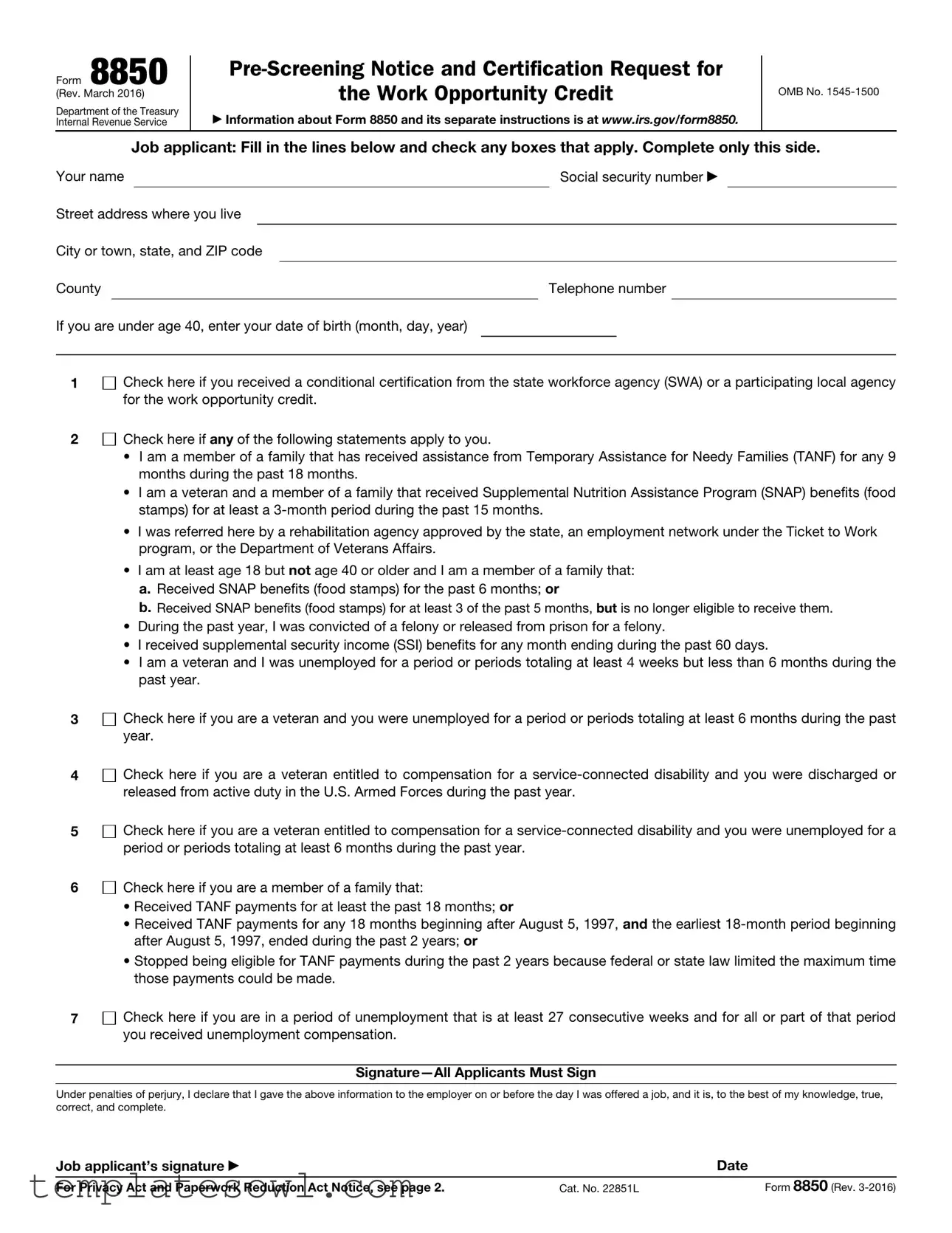What is IRS Form 8850?
IRS Form 8850 is a document used for the Pre-Screening Notice and Certification Request for the Work Opportunity Credit. This credit is designed to incentivize employers to hire individuals from specific target groups that face barriers to employment.
Who needs to fill out Form 8850?
Job applicants who believe they qualify for the Work Opportunity Credit should complete Form 8850. It can help applicants demonstrate eligibility to potential employers based on their background or circumstances, such as receiving certain types of public assistance or being a veteran.
What information must be provided on the form?
The form requires basic personal information such as the applicant's name, Social Security number, address, date of birth, and phone number. Additionally, the applicant must indicate if they received a conditional certification from a state workforce agency or if any statements about their background apply to them, such as receiving TANF or SNAP benefits.
How does an applicant prove eligibility?
Applicants can prove eligibility by checking corresponding boxes on the form that reflect their circumstances. These may include factors like being a veteran, receiving disability compensation, or having a felony conviction. The state workforce agency will verify this information if required.
What are the target groups for the Work Opportunity Credit?
Several target groups are eligible for the Work Opportunity Credit, including veterans, recipients of Temporary Assistance for Needy Families (TANF), individuals with felony convictions, and those who have received Supplemental Nutrition Assistance Program (SNAP) benefits. Each group has specific criteria that must be met to qualify.
Do I need to submit Form 8850 with my job application?
While it is not mandatory to submit Form 8850 with every job application, it is advantageous if you believe you qualify for the Work Opportunity Credit. Doing so can help demonstrate your eligibility to employers and potentially increase your chances of being hired.
How do employers use Form 8850?
Employers use this form to request certification from the state workforce agency, verifying whether the individual is a member of a targeted group. This certification is necessary for employers to claim the Work Opportunity Credit on their tax returns, thereby potentially reducing their tax liability.
What happens after the form is submitted?
Once the employer submits Form 8850 to the state workforce agency, it will review the information provided. The agency will verify the applicant's eligibility and provide certification if the applicant meets the necessary criteria. Employers should keep a record of this information for their tax records.
Are there any penalties for providing false information on Form 8850?
Yes, all applicants must sign the form, declaring that the information provided is true, correct, and complete under penalties of perjury. Providing false information can lead to legal consequences and disqualification from the Work Opportunity Credit.
Where can I find more information about Form 8850?
For more details about IRS Form 8850 and its instructions, one can visit the IRS website at www.irs.gov/form8850. This resource contains comprehensive information about eligibility, completion, and submission of the form.



 Check here if you received a conditional certification from the state workforce agency (SWA) or a participating local agency for the work opportunity credit.
Check here if you received a conditional certification from the state workforce agency (SWA) or a participating local agency for the work opportunity credit.
 Check here if
Check here if 
 Check here if you are a veteran and you were unemployed for a period or periods totaling at least 6 months during the past year.
Check here if you are a veteran and you were unemployed for a period or periods totaling at least 6 months during the past year.
 Check here if you are a veteran entitled to compensation for a
Check here if you are a veteran entitled to compensation for a 
 Check here if you are a veteran entitled to compensation for a
Check here if you are a veteran entitled to compensation for a 
 Check here if you are a member of a family that:
Check here if you are a member of a family that: Check here if you are in a period of unemployment that is at least 27 consecutive weeks and for all or part of that period you received unemployment compensation.
Check here if you are in a period of unemployment that is at least 27 consecutive weeks and for all or part of that period you received unemployment compensation.